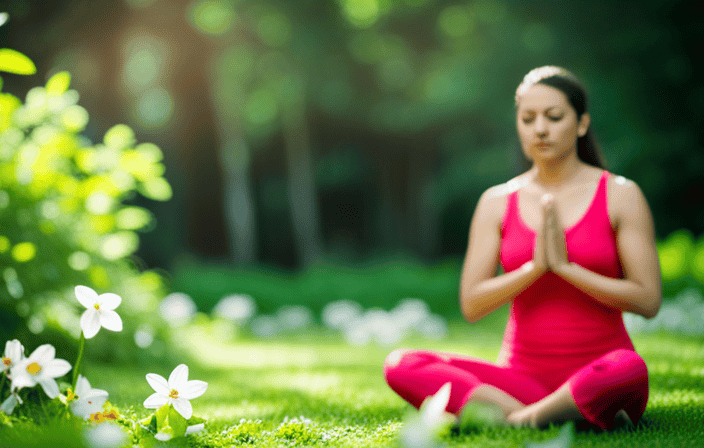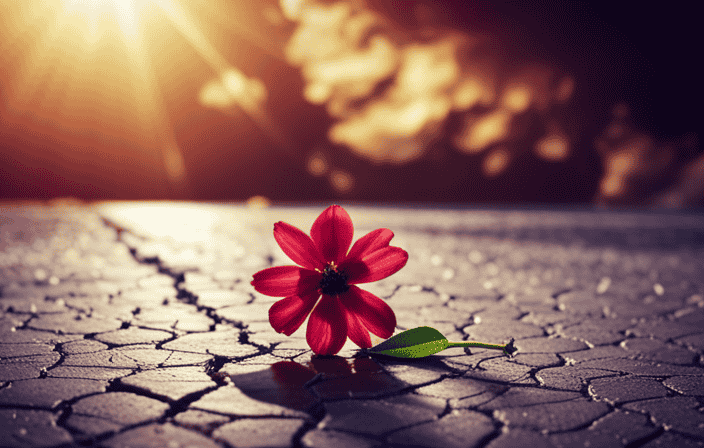Meditation
Itchy Palms: Medical And Spiritual Reasons Explained

Were you aware that the sensation of itchy palms might stem from both health-related and metaphysical reasons? Various medical issues, including deficiencies in vitamins, skin disorders, allergic reactions, and insufficient blood flow, can trigger itching in one’s palms.
Interestingly, itchy left palms are traditionally associated with potential financial loss, while itchy right palms are linked to financial gain.
In this article, we will explore the causes of itchy palms, the connection to diabetes, the spiritual meanings, and the importance of seeking medical advice.
Stay tuned to learn more about this intriguing phenomenon.
Key Takeaways
- Itchy palms can be caused by various medical conditions, deficiencies in vitamins, skin conditions, allergies, stress, and poor circulation.
- Uncontrolled diabetes or pre-diabetes can cause extremely dry skin and itchiness in the palms.
- Itchy left palm is traditionally associated with potential financial loss, while itchy right palm is linked to financial gain according to spiritual beliefs.
- Seek medical attention for chronic or severe itchiness, avoid irritants, use dry skin-friendly products, and visit a doctor to rule out serious conditions like diabetes.
Causes of Itching
Various medical conditions and deficiencies in vitamins can lead to dry and itchy palms. Skin conditions, allergic reactions, stress, and poor circulation can also contribute to itchiness. Psychological factors, such as stress and anxiety, can trigger hives or overactive nerves, resulting in itchiness. Additionally, poor circulation can contribute to itchy palms.
When it comes to natural remedies for itchy palms, there are a few options to consider. Using dry skin-friendly hand soap and lotion, avoiding overwashing the hands, and wearing gloves during activities that may irritate the skin can help alleviate itchiness. Hydrating well and maintaining a balanced diet for overall skin health can also be beneficial. Applying petroleum jelly at night can help moisturize the palms and provide relief.
Link to Diabetes
Uncontrolled diabetes or pre-diabetes can act as a catalyst for excessively dry skin and itchiness, highlighting its potential to exacerbate discomfort.
Diabetes can cause poor circulation, leading to dryness and itchiness in the palms. Additionally, diabetes can also result in nerve damage, further contributing to itchiness.
Managing diabetes is crucial to alleviate symptoms of itchy palms. It is important for individuals with diabetes to maintain good blood sugar control through medication, diet, and exercise.
Tips for hand care include avoiding overwashing the hands, using gentle and dry skin-friendly products, and wearing gloves during activities that may irritate the skin.
Hydrating well and maintaining a balanced diet can also help improve overall skin health.
Regular check-ups with a healthcare provider are essential to monitor and manage diabetes effectively.
Spiritual Meanings
The potential connections between itchy palms and financial outcomes have been explored in spiritual beliefs and biblical references. Cultural beliefs and superstitions regarding itchy palms vary across different traditions and individuals.
Interpretations of biblical verses, such as Ecclesiastes 10:2 and Isaiah 41:13, mention the left and right palms in relation to financial loss and gain, respectively. However, it is important to note that these interpretations may vary and should be considered within personal beliefs.
Superstitions related to itchy palms often suggest making wise financial decisions during an itchy left palm, exercising caution and avoiding overspending during an itchy right palm. These beliefs reflect the idea of being prepared for potential financial gain or loss and respecting personal beliefs and superstitions when it comes to itchy palms.
Medical Actions
One important step to address and alleviate discomfort associated with palm itchiness is seeking medical attention for proper evaluation and treatment. Chronic or severe itchiness may require medical evaluation as it could be a symptom of an underlying medical condition. Doctors can provide appropriate treatment and alleviate discomfort, improving the quality of life and preventing further complications.
Preventive measures for itchy palms include avoiding overwashing hands and wearing gloves during certain activities. Additionally, it is important to stop using any irritating lotions or soaps and instead use dry skin-friendly hand soap and lotion. Applying petroleum jelly at night can help moisturize the palms. In some cases, medications for itchiness may be prescribed by the doctor to provide relief.
It is crucial to visit a doctor to rule out serious conditions like diabetes and receive proper care.
Superstition Actions
To address the superstition-related aspects of palm itchiness, individuals may choose to make wise financial decisions and exercise caution during periods of itchiness in their left palm to potentially avoid unnecessary spending and major financial decisions. This is based on cultural beliefs and interpretations that associate an itchy left palm with possible financial loss.
To further understand the significance of these beliefs, it is important to consider biblical references such as Ecclesiastes 10:2, which suggests that a foolish man directs towards the left, potentially indicating financial loss. On the other hand, an itchy right palm is typically linked to financial gain, as mentioned in Isaiah 41:13, which mentions holding the right hand open to receive blessings.
It is worth noting that interpretations of these biblical verses and superstitions may vary, and individuals are free to interpret these signs as they wish.
Financial Outcomes
Financial outcomes related to palm itchiness can vary and are not solely limited to literal monetary gain or loss. According to spiritual beliefs, an itchy left palm is traditionally associated with potential financial loss, while an itchy right palm is typically linked to financial gain. These interpretations can be found in biblical verses such as Ecclesiastes 10:2, which suggests that a foolish man directs towards the left, potentially indicating financial loss, and Isaiah 41:13, which mentions holding the right hand open to receive blessings, suggesting financial gain.
However, it is important to note that these interpretations may vary and should be considered within personal beliefs. Therefore, individuals should exercise caution and make wise financial decisions during an itchy left palm, while avoiding overspending during an itchy right palm.
Self-Care Measures
Self-care measures for relieving itchiness in the palms include:
- Refraining from excessive handwashing
- Using gentle, dry skin-friendly products
- Wearing gloves during activities that may irritate the skin
Preventing dryness is crucial in managing itchiness. It is important to avoid overwashing hands, as this can strip the skin of its natural oils and contribute to dryness. Using gentle, dry skin-friendly products such as hand soap and lotion can help maintain the skin’s moisture balance.
Moisturizing the palms regularly is essential in preventing dryness and itchiness. Applying petroleum jelly at night can help lock in moisture and alleviate dry skin.
Wearing gloves during activities that may irritate the skin, such as cleaning or gardening, can also provide a protective barrier and prevent further irritation.
By implementing these self-care measures, individuals can effectively manage and alleviate itchiness in their palms.
Importance of Seeking Medical Advice
Seeking medical advice is crucial when experiencing itchy palms as it can help diagnose any underlying medical conditions and provide appropriate treatment. Doctors play a vital role in identifying the cause of itchiness and determining if it is a symptom of a more serious condition, such as diabetes. Early medical intervention can alleviate discomfort and prevent further complications.
It is important to prioritize medical evaluation for chronic or severe itchiness, as it may require specialized treatment. By ruling out serious conditions and receiving proper medical care, individuals can improve their quality of life and find relief from their symptoms.
Some benefits of seeking medical advice for itchy palms include accurate diagnosis, personalized treatment plans, and the ability to address any potential underlying health issues.
- Doctors can accurately diagnose the cause of itchiness in the palms
- Early medical intervention can prevent further complications
- Personalized treatment plans can be developed based on the underlying cause
- Medical evaluation can rule out serious conditions such as diabetes
- Seeking medical advice can improve quality of life and provide relief from symptoms.
Signs of Serious Conditions
One indicator of potential underlying health issues is the presence of chronic or severe itchiness in the palms. Itchy palms can be a symptom of various medical conditions, including nerve conditions. The relationship between itchy palms and nerve conditions is complex and not fully understood. However, it has been observed that certain nerve conditions, such as peripheral neuropathy, can cause itching sensations in the palms. Additionally, the psychological effects of itchy palms should not be overlooked. Chronic itchiness can significantly impact a person’s quality of life, leading to sleep disturbances, anxiety, and depression. Therefore, it is important to seek medical advice if you experience persistent or severe itchiness in your palms. A healthcare professional can evaluate your symptoms, conduct appropriate tests, and provide appropriate treatment to alleviate discomfort and address any underlying health issues.
| Psychological Effects of Itchy Palms | Relationship between Itchy Palms and Nerve Conditions | Importance of Seeking Medical Advice |
|---|---|---|
| Sleep disturbances | Peripheral neuropathy | Persistent or severe itchiness |
| Anxiety | Underlying health issues | |
| Depression | Appropriate treatment |
Skin Conditions that Cause Itching
Skin conditions such as eczema, allergies, psoriasis, or exfoliative keratolysis can cause itching. These conditions can result in dry and itchy skin on the palms. Common symptoms of itchy palms include redness, swelling, dryness, and a persistent urge to scratch.
Eczema, for example, is characterized by inflamed and itchy patches of skin, while psoriasis causes thick, scaly skin that may crack and bleed. Allergies can lead to itchy palms when the skin comes into contact with certain allergens. Exfoliative keratolysis is a condition characterized by the peeling of the skin, which can also cause itchiness.
Fortunately, there are natural remedies that can help alleviate the discomfort of itchy palms. Moisturizing the skin regularly with fragrance-free lotions or creams can help keep the skin hydrated and prevent dryness. Applying aloe vera gel or coconut oil to the affected areas can also provide relief. Additionally, wearing gloves when engaging in activities that may irritate the skin, such as washing dishes or gardening, can protect the palms from further irritation.
It is important to note, however, that if the symptoms persist or worsen, it is advisable to seek medical attention for a proper diagnosis and treatment.
Impact of Stress and Anxiety
The impact of stress and anxiety on the body can manifest in various ways, and one such manifestation includes the sensation of itchiness and discomfort in the palms. Stress and anxiety have been found to affect skin health, leading to the development or exacerbation of various skin conditions, including itchiness. The exact mechanisms through which stress influences the skin are not fully understood, but it is believed that stress hormones, such as cortisol, play a role in disrupting the skin’s natural barrier function and increasing inflammation.
To cope with anxiety and reduce the impact on skin health, individuals can engage in stress management techniques such as relaxation exercises, meditation, and regular physical activity. Additionally, maintaining a healthy lifestyle with a balanced diet, adequate sleep, and minimizing exposure to stressors can also help alleviate symptoms. Seeking support from mental health professionals or participating in therapy can provide individuals with effective coping mechanisms to manage stress and anxiety, ultimately improving overall well-being, including skin health.
| Effect of stress on skin health | Coping mechanisms for anxiety |
|---|---|
| Disruption of skin barrier function | Relaxation exercises |
| Increased inflammation | Meditation |
| Exacerbation of skin conditions | Regular physical activity |
| Dryness and itchiness | Healthy lifestyle choices |
| Impaired wound healing | Seeking support from mental health professionals |
Frequently Asked Questions
Can itchy palms be a sign of a serious medical condition?
Itchy palms can be a sign of a serious medical condition such as uncontrolled diabetes or poor circulation. However, it is important to note that itchy palms are also associated with superstitions and the connection between itchy palms and financial luck.
Are there any specific skin conditions that commonly cause itching in the palms?
Skin conditions such as eczema and allergies are common causes of itching in the palms. Dry skin is another frequent culprit. It is important to address these underlying issues to alleviate discomfort and prevent further complications.
How does stress and anxiety contribute to itchy palms?
Stress and anxiety can contribute to itchy palms through the activation of the body’s stress response, which can lead to the release of histamines and cause skin itching. The link between mental health and itchy palms is mediated by the body’s physiological response to stress.
Are there any signs that indicate the need for immediate medical attention?
Immediate medical attention is crucial if certain signs accompany itchy palms, such as severe or chronic itchiness, uncontrolled diabetes, or poor circulation. Early diagnosis is important for appropriate treatment and prevention of complications.
Can self-care measures effectively alleviate itchy palms, or is medical intervention necessary?
Self-care measures, such as refraining from overwashing hands, using gentle products, and moisturizing with petroleum jelly, can provide relief for itchy palms. While alternative remedies may be attempted, medical intervention may be necessary for chronic or severe cases.
Say hello to Cypress, the soulful wordsmith behind the insightful articles at OurMindAndBody.com. Cypress is a gifted writer who weaves words with grace and precision, using language as a powerful tool to inspire, heal, and uplift the spirits of readers.
With a background in literature and a passion for personal growth, Cypress brings a unique perspective to the world of well-being and spirituality. Having experienced the transformative effects of meditation and yoga firsthand, Cypress is deeply connected to the essence of these practices and their potential to enrich lives.
Meditation
Unveiling The Mysteries Of Tantric Meditation

Enter the world of tantric meditation, where the enigmas of the mind and body blend together in a graceful dance.
Like a hidden treasure waiting to be discovered, this ancient practice unveils a path to deep connection and profound transformation.
Through sacred positions and nurturing practices, tantric meditation invites us to explore the depths of our being, embracing our desires and harnessing our sexual energy for spiritual awakening.
Join me on this journey as we unravel the secrets and unlock the power of tantric meditation.
Key Takeaways
- Tantric meditation integrates spirituality, mindfulness, and sexuality.
- It recognizes sexual energy as sacred and transformative.
- Trust, openness, and vulnerability are essential for tantric meditation.
- The practice cultivates deep connection, intimacy, and personal growth.
What is it?
I can explain what tantric meditation is in the context of the pre-existing knowledge.
Tantric meditation is a practice that integrates spirituality, mindfulness, and sexuality, taking a holistic approach to the human experience. It embraces our physical desires and sensory experiences, recognizing sexual energy as sacred and transformative.
What sets tantric meditation apart is its emphasis on connection and intimacy with oneself and others. It goes beyond traditional meditation practices by incorporating the exploration of our deepest desires and the cultivation of a deep sense of connection and trust.
Tantric meditation can be practiced individually or with a partner, and it is not limited to any specific religious tradition. It is a practice that invites us to approach our spirituality and sexuality with openness, respect, and a willingness to explore and grow.
Practices and Positions
A variety of positions and practices can be utilized in tantric meditation to foster trust, openness, and vulnerability while deepening connections with oneself and others. These practices are designed to create a safe and supportive environment for spiritual evolution.
Here are three key positions and practices commonly used in tantric meditation:
-
Nurturing Meditation: Sit facing your partner, place your hands on each other’s hearts, make eye contact, and synchronize your breath. This practice promotes a sense of deep connection and intimacy.
-
Yab-Yum or Lotus: In this position, one partner sits in the lap of the other, maintaining eye contact. This symbolizes the union of energies and fosters a sense of unity and harmony.
-
Hands On Hearts: Sit facing your partner, place your hands on each other’s hearts, make eye contact, and focus on the energy flowing between you. This practice cultivates trust, openness, and vulnerability.
These positions and practices can be adapted based on comfort and preferences, allowing individuals to explore and deepen their spiritual connection in a way that feels authentic to them.
Unique Characteristics
Integrating spirituality, mindfulness, and sexuality, tantric meditation offers a holistic approach to human experience. Unlike other forms of meditation, tantric meditation embraces our physical desires and sensory experiences, recognizing sexual energy as sacred and transformative. It emphasizes the importance of connection and intimacy with oneself and others, allowing us to explore the depths of our being.
By integrating our spirituality, mindfulness, and sexuality, we can tap into a profound sense of self-discovery and personal growth. Tantric meditation promotes mindfulness and connection with the divine, allowing us to harness our sexual energy for spiritual transformation. This unique practice fosters a holistic approach to spiritual awakening, inviting us to explore the depths of our desires and emotions, and ultimately leading us to a more profound sense of connection and fulfillment.
FAQs and General Information
One important aspect of tantric meditation is that it can be practiced individually, not just by couples. This means that anyone, regardless of their relationship status, can experience the transformative power of tantric meditation.
Here are some frequently asked questions and general information about tantric meditation:
-
Is tantric meditation only about sexuality?
- No, tantric meditation integrates spirituality, mindfulness, and sexuality. It takes a holistic approach to the human experience, recognizing the sacredness and transformative nature of sexual energy.
-
Is tantric meditation limited to specific religions?
- No, tantric meditation can be found in various traditions and is not exclusive to Hinduism and Buddhism. It is a practice that can be adapted and practiced by anyone with respect and openness.
-
Can tantric meditation be combined with other spiritual practices?
- Yes, tantric meditation can be combined with other forms of meditation or spiritual practices. It is a versatile practice that can enhance and complement other spiritual journeys.
-
Do I need to have a partner to practice tantric meditation?
- No, tantric meditation can be practiced individually. While some positions and practices involve a partner, there are also solo practices that allow for deepening connection and intimacy with oneself.
Importance of Trust
Trust is an essential component of tantric practice as it allows for deepening connection and exploration. When engaging in tantric meditation, trust creates a safe and supportive environment for spiritual evolution. It is the foundation upon which profound intimacy and vulnerability can be built. Trust allows us to let go of inhibitions, fears, and doubts, enabling us to fully surrender to the experience.
It is through trust that we can open ourselves up to the transformative power of tantric meditation. By trusting ourselves and our partners, we create a space where authenticity and acceptance thrive. Trust fosters a sense of security, allowing us to explore our desires and boundaries without judgment.
It is through trust that we can truly connect with ourselves, others, and the divine, unlocking the mysteries and experiencing the profound benefits of tantric meditation.
Benefits and Goals
Enhancing self-discovery and personal growth through tantric practices and meditation is a profound goal. By embracing the holistic approach of tantric meditation, we can unlock a wealth of benefits and achieve our highest potential.
Here are three key ways in which tantric meditation can enrich our lives:
-
Deep Connection and Intimacy: Through tantric practices, we can cultivate a profound sense of connection and intimacy with ourselves and others. By embracing our physical desires and sensory experiences, we can create a space for deepening our relationships and fostering genuine connections.
-
Spiritual Transformation: Tantric meditation harnesses the power of sexual energy to facilitate spiritual transformation. By recognizing sexual energy as sacred and transformative, we can tap into its immense potential for personal growth and spiritual evolution.
-
Mindfulness and Divine Connection: Tantric meditation promotes mindfulness and enhances our connection with the divine. By integrating spirituality and mindfulness into our practice, we can cultivate a deeper awareness of ourselves and our connection to the world around us.
In conclusion, tantric meditation offers a unique pathway to self-discovery, personal growth, and spiritual awakening. By embracing its teachings and practices, we can embark on a transformative journey towards greater fulfillment and enlightenment.
Integration with Other Practices
Now that we have explored the benefits and goals of tantric meditation, let’s delve into the fascinating way in which it can be integrated with other practices. Tantric meditation is not limited to being practiced in isolation, but can be combined with various spiritual and meditative techniques to deepen and enhance our experience. By integrating tantric meditation with other practices, we can tap into different aspects of our being and open ourselves up to new dimensions of growth and transformation.
To illustrate the possibilities, let’s consider a 3-column table that showcases some examples of how tantric meditation can be integrated with other practices:
| Practice | Description | Benefits |
|---|---|---|
| Yoga | Combining tantric meditation with yoga asanas can enhance body awareness and energy flow, promoting physical and spiritual health. | Increased flexibility, improved focus, and heightened spiritual connection. |
| Breathwork | Incorporating breathwork techniques with tantric meditation can deepen the connection to our life force energy, intensify sensations, and expand consciousness. | Enhanced breath control, increased energy flow, and expanded states of awareness. |
| Sound Healing | Integrating sound healing practices, such as chanting or listening to sacred music, with tantric meditation can amplify the vibrational energy and facilitate deeper states of relaxation and spiritual connection. | Heightened sense of peace, harmonized energy centers, and enhanced spiritual experiences. |
By integrating tantric meditation with other practices, we can explore new dimensions of our being, deepen our spiritual connection, and expand our personal growth and transformation. It is a beautiful way to create a holistic approach to our spiritual awakening.
Creating a Safe Environment
To ensure a safe environment for practicing tantric meditation, it is important to establish clear boundaries and communicate openly with oneself and others. This means being aware of personal limits and expressing them honestly.
It also involves actively listening to the needs and desires of your partner or partners, and respecting their boundaries as well. Creating a safe space requires trust, openness, and vulnerability, where everyone feels comfortable and supported.
It is essential to have open and honest conversations about consent, desires, and intentions before engaging in any tantric practices. This allows for a deeper level of connection and understanding, fostering a sense of safety and security.
By creating this safe environment, we can fully explore the transformative power of tantric meditation and experience profound spiritual growth.
Frequently Asked Questions
How can tantric meditation be integrated with other forms of meditation or spiritual practices?
To integrate tantric meditation with other forms of meditation or spiritual practices, one can incorporate tantric principles like mindfulness, connection, and embracing physical desires into their existing practice. This can deepen the experience and bring a more holistic approach to spiritual growth.
Can tantric meditation be practiced by individuals who are not in a romantic relationship?
Absolutely! Tantric meditation can be practiced by individuals who are not in a romantic relationship. It is a beautiful path of self-discovery, personal growth, and spiritual transformation that can be embraced by anyone with openness and respect.
Is tantric meditation limited to Hinduism and Buddhism, or is it found in other traditions as well?
Tantric meditation is not limited to Hinduism and Buddhism, as it can be found in various traditions. It is a practice that can be embraced by anyone with respect and openness, regardless of their religious or spiritual background.
What are some specific techniques or exercises that can be practiced during tantric meditation?
During tantric meditation, specific techniques and exercises can be practiced to deepen connection and intimacy. These include nurturing meditation, yab-yum or lotus position, and hands on hearts. These practices foster trust, openness, and vulnerability.
How does tantric meditation specifically harness and transform sexual energy for spiritual purposes?
Tantric meditation harnesses and transforms sexual energy for spiritual purposes by recognizing it as sacred and transformative. Through practices such as breathwork, visualization, and mindfulness, sexual energy is channeled and directed towards spiritual growth, self-discovery, and deepening connection with oneself and others.
Meet Nadi, the soulful writer and explorer of inner realms who graces OurMindAndBody.com with her profound insights and heartfelt wisdom. With a profound passion for mindfulness, meditation, and spiritual growth, Nadi weaves words that touch the hearts and minds of readers, leaving a lasting impact on their well-being journey.
Rooted in a background of philosophy and psychology, Nadi’s curiosity about the human mind and the mysteries of the soul led her on a transformative path of self-discovery. Drawn to the transformative power of mindfulness and meditation, she embarked on a quest to understand the intricacies of these practices, not only for her own growth but also to inspire others to embark on their own inner journeys.
Meditation
Unlocking The Power Of Flower Energy In Meditation
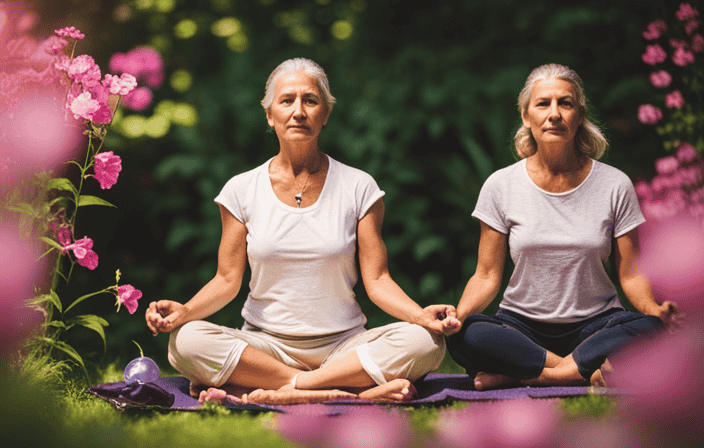
Similar to a fragile flower blossoming under the gentle caress of sunlight, flower meditation enables us to tap into the unseen potential of nature’s energy that lies within us.
In this article, we will explore the transformative benefits of flower meditation, from reducing stress and anxiety to fostering a deep connection with the natural world.
Through this practice, we can align our mind, body, and spirit, bringing peace and tranquility into our lives.
Join me on this spiritual journey as we discover the profound effects of harnessing the power of flower energy in meditation.
Key Takeaways
- Flower meditation heightens self-awareness.
- Engaging with flowers reduces stress, anxiety, and tension.
- Flower meditation fosters a connection with nature.
- Flower energy aligns the mind, body, and spirit.
What is it?
Flower meditation is a practice that I can incorporate into my daily life to unlock the power of flower energy and enhance my overall well-being.
It is a beautiful and calming practice that allows me to connect with nature on a deeper level. By focusing my attention on the intricate details of a flower, I become more present and mindful.
This practice heightens my self-awareness and brings clarity to my thoughts and emotions. The soothing effect of flowers helps me to reduce stress, anxiety, and tension. As I engage with the energy of flowers, I feel a sense of peace and tranquility wash over me.
Flower meditation aligns my mind, body, and spirit, creating a harmonious balance within me. It is a practice that nourishes and revitalizes my being, leaving me feeling more connected and alive.
Benefits of Flower Meditation
Engaging in this practice heightens my self-awareness and promotes living with intention. Flower meditation allows me to focus on the present moment, cultivating mindfulness and bringing clarity to my conscious choices. The soothing effect of flowers on my mind and body reduces stress, anxiety, and tension, promoting relaxation and a sense of peace.
Through flower meditation, I foster a deep connection with nature, immersing myself in the beauty of flowers and developing an appreciation for the natural world. This practice also encourages environmental consciousness, reminding me of my relationship with the Earth and the importance of mindfulness towards it.
Furthermore, flower energy aligns my mind, body, and spirit, creating balance and enhancing my holistic well-being. It merges with my personal energy, revitalizing me and improving my overall vitality.
Incorporating flower meditation into my daily life is simple. I display fresh flowers as a visual reminder of the present moment, take mindful walks in nature to observe flowers, create flower arrangements, and practice gratitude for the beauty of flowers and nature.
Flower meditation truly unlocks the power of flower energy, allowing me to experience a deeper connection with myself, nature, and the universe.
Connection with Nature
Immersing in the beauty of nature through this practice fosters a deep connection with the environment and cultivates an appreciation for its wonders.
Flower meditation encourages us to slow down and truly observe the intricate details and vibrant colors of the flowers around us.
As we take mindful walks in nature and observe the flowers, we become more aware of the interconnectedness of all living beings and the importance of preserving the natural world.
This awareness promotes environmental consciousness and a sense of responsibility towards the Earth.
The beauty and tranquility of flowers remind us to be grateful for the gifts of nature and to treat the Earth with respect and care.
Through flower meditation, we can deepen our connection with nature and find solace and inspiration in its ever-changing beauty.
Mind-Body-Spirit Connection
Through this practice, I feel a deep sense of alignment between my mind, body, and spirit.
As I engage in flower meditation, I am reminded of the interconnectedness of all aspects of my being.
The energy of the flowers merges with my own, creating a harmonious balance within me.
I become more aware of any imbalances or areas that need attention, allowing me to address them with compassion and kindness.
This connection between my mind, body, and spirit enhances my overall well-being and vitality.
I am able to tap into a profound sense of inner peace and clarity.
The flower energy acts as a gentle guide, leading me towards a higher level of consciousness and spiritual growth.
It is truly a transformative experience that nourishes my entire being.
Incorporating into Daily Life
Incorporating flower meditation into my daily life allows me to create a deeper connection with nature and cultivate a sense of mindfulness. Displaying fresh flowers in my home serves as a visual reminder to stay present and appreciate the beauty of the present moment.
Taking mindful walks in nature and observing the intricate details of flowers helps me to immerse myself in the natural world and develop a sense of gratitude for its wonders. I also enjoy creating flower arrangements and participating in floral crafts, which not only brings me joy but also allows me to express my creativity.
By practicing gratitude for the beauty of flowers and nature, I feel a profound sense of peace and tranquility. Flower meditation has truly become an integral part of my daily routine, bringing me closer to nature and enhancing my overall well-being.
Types of Flower Meditation
By exploring different techniques such as rose meditation and golden flower meditation, I have discovered new ways to deepen my spiritual practice and expand my consciousness.
Rose meditation has been a profound experience for me, as it allows me to tap into self-love, compassion, and emotional healing. Focusing on the delicate petals of a rose brings a sense of peace and acceptance into my being. It reminds me to be gentle with myself and others, fostering a deep connection with the world around me.
On the other hand, golden flower meditation has opened up a whole new realm of spiritual insights. Visualizing an imaginary golden flower within my body has helped me access higher levels of consciousness and awareness. It is a powerful practice that brings clarity and enlightenment to my journey.
Exploring these different types of flower meditation has truly transformed my spiritual path, allowing me to unlock the immense power of flower energy in my meditation practice.
Exploring different types of flower meditation has expanded my spiritual practice and deepened my connection to the world around me. Each type of flower meditation has its own unique energy and intention, allowing me to explore different aspects of myself and the universe.
-
Rose meditation: By focusing on a rose, I am reminded of the power of self-love and compassion. It brings forth emotions of tenderness and nurturance, allowing me to heal and grow emotionally.
-
Golden flower meditation: This practice takes me on a journey within, as I visualize an imaginary golden flower. It helps me tap into higher levels of consciousness and spiritual insights, guiding me towards profound awareness and enlightenment.
-
Nature immersion meditation: By simply observing flowers in nature, I am filled with awe and wonder. It reminds me of the interconnectedness of all living beings and the beauty that surrounds us. It evokes a sense of gratitude and reverence for the natural world.
Through these different types of flower meditation, I am able to unlock the power of flower energy and experience a deeper sense of peace, harmony, and spiritual growth.
Engaging in different types of flower meditation has deepened my spiritual practice and allowed me to connect more profoundly with myself and the world around me.
The beauty and energy of flowers have a transformative effect on my meditation experience. When I choose a flower as my focal point, I am able to observe its intricate details and immerse myself in its essence.
Whether it’s the self-love and compassion of rose meditation or the awakening of spiritual insights through golden flower meditation, each practice brings a sense of peace and tranquility.
As I merge my personal energy with the flower’s energy, I feel a harmonious balance within myself.
Flower meditation has become an integral part of my daily life, reminding me to be present, grateful, and connected to the natural world.
Frequently Asked Questions
How can I choose the right flower for my meditation practice?
To choose the right flower for your meditation practice, trust your intuition. Allow yourself to be drawn to a flower that resonates with you, whether it’s for its color, scent, or symbolism. Let the flower guide and support your meditation journey.
Can flower meditation be done indoors, or does it have to be in nature?
Yes, flower meditation can be done indoors. Although being in nature enhances the experience, the soothing energy of flowers can still be harnessed indoors. Simply bring fresh flowers into your meditation space and let their beauty and tranquility guide you.
Are there any specific techniques or methods to enhance the effects of flower meditation?
To enhance the effects of flower meditation, I suggest deepening your focus on the chosen flower, allowing its energy to flow through you. Visualize the flower’s qualities and intentions, and maintain a state of gratitude and receptivity throughout the practice.
Can flower meditation help with specific physical or mental health issues?
Flower meditation has the potential to assist with various physical and mental health issues. By promoting relaxation, reducing stress, and increasing self-awareness, it can contribute to overall well-being and healing.
Are there any precautions or considerations to keep in mind when practicing flower meditation?
When practicing flower meditation, it’s important to approach it with an open mind and respect for nature. Take care to choose flowers that are safe for you and your environment, and ensure a peaceful and distraction-free space for your practice.
Meet Nadi, the soulful writer and explorer of inner realms who graces OurMindAndBody.com with her profound insights and heartfelt wisdom. With a profound passion for mindfulness, meditation, and spiritual growth, Nadi weaves words that touch the hearts and minds of readers, leaving a lasting impact on their well-being journey.
Rooted in a background of philosophy and psychology, Nadi’s curiosity about the human mind and the mysteries of the soul led her on a transformative path of self-discovery. Drawn to the transformative power of mindfulness and meditation, she embarked on a quest to understand the intricacies of these practices, not only for her own growth but also to inspire others to embark on their own inner journeys.
Meditation
Unleashing Emotions: The Transformative Power Of Crying In Meditation
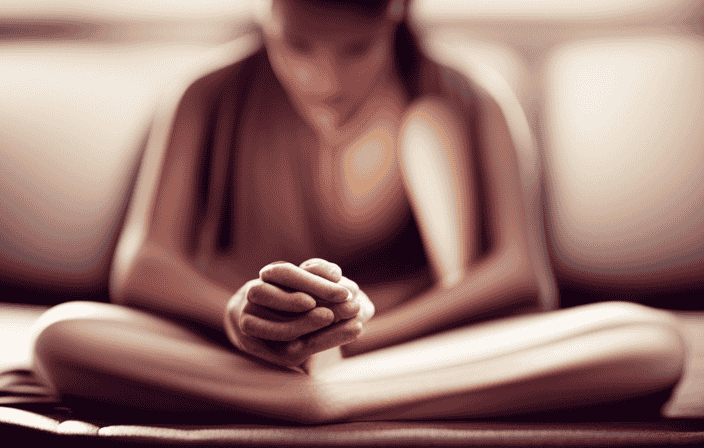
In the practice of meditation, tears are considered to be the windows to the soul, reflecting one’s innermost emotions and experiences.
Crying during meditation may seem surprising or even uncomfortable, but it is a powerful and transformative experience. In this article, we will explore the profound impact that crying can have on our emotional well-being and personal growth.
Through the release of pent-up emotions and the exploration of buried feelings, we can find healing, clarity, and inner peace. Get ready to embrace the transformative power of crying in meditation.
Key Takeaways
- Crying is a common occurrence during meditation and can signify a release of pent-up emotions.
- Crying during meditation can be a deeply transformative experience, offering an opportunity for self-awareness and growth.
- Each individual’s experience with meditation may vary, but addressing emotions can help balance and heal chakras.
- Tears symbolize a release of emotional burdens and can bring a sense of relief and clarity.
The Transformative Power
Crying during meditation has been a deeply transformative experience for me, offering the opportunity for self-awareness and growth. It is a powerful release of pent-up emotions that allows for emotional breakthroughs and healing.
As tears flow, they wash away emotional burdens and bring a sense of relief and clarity. This cathartic experience helps me confront and address suppressed feelings, creating a safe space for profound self-reflection.
Through meditation, I have learned that each individual’s experience may vary, but tears are often seen as a sign of healing. Embracing tears as a natural part of the meditation journey has allowed me to balance and heal my chakras, bringing inner peace and emotional well-being.
With the encouragement of emotional release during meditation, I have been able to explore and transform my emotions in a profound and meaningful way.
Emotional Release in Meditation
During meditation, I often experience a cathartic release of pent-up emotions. It is a powerful and transformative experience that allows me to confront and address buried emotions and unresolved trauma.
As I delve into my consciousness, these emotions surface and manifest in the form of tears. Crying during meditation is not uncommon, and it symbolizes a release of emotional burdens. It creates a safe space for me to explore and express my suppressed feelings.
Through this emotional release, I am able to find inner peace and clarity. It is a natural part of the meditation journey, and each individual’s experience may vary.
Embracing tears during meditation helps me wash away emotional baggage and promotes self-awareness and growth.
Confronting Buried Emotions
Confronting buried emotions in meditation allows me to delve into the depths of my consciousness and address unresolved trauma. During meditation, I create a safe space for these emotions to arise and be explored.
It is a transformative process that helps me gain self-awareness and promotes personal growth. Through this practice, I have come to understand that tears symbolize a release of pent-up emotions. They serve as a cathartic experience, allowing me to wash away emotional burdens and find inner peace.
Each individual’s experience may vary, as meditation acts as a powerful tool for self-reflection and confronting suppressed feelings. Embracing tears as a natural part of the meditation journey is essential, as they signify emotional breakthroughs and bring about emotional clarity and relief.
Significance of Tears
Experiencing tears during my meditation practice is a powerful way for me to release pent-up emotions and find emotional clarity. It may seem surprising, but tears have a deep significance in the meditation journey. Here are four reasons why tears are important during meditation:
-
Symbol of release: Tears often symbolize a release of pent-up emotions. They act as a natural outlet to let go of emotional burdens that have been weighing us down.
-
Sign of healing: Crying during meditation can be a sign of healing. It allows us to confront and process unresolved trauma or suppressed feelings, leading to emotional growth and self-awareness.
-
Relief and clarity: Shedding tears brings a sense of relief and emotional clarity. It washes away emotional burdens, creating space for inner peace and a renewed perspective.
-
Encouragement for emotional exploration: Meditation provides a safe space for emotions to arise and be explored. Tears are welcomed as part of the process, encouraging us to confront and address our emotions for greater balance and healing.
Incorporating tears into my meditation practice has been transformative, helping me to embrace my emotions and find a deeper sense of well-being.
Balancing and Healing Chakras
Balancing and healing my chakras through meditation has brought a sense of harmony and well-being to my life.
Chakras are energy centers in the body, and when they are balanced, it promotes physical, emotional, and spiritual health.
During meditation, I focus on each chakra, allowing any blockages or imbalances to be released.
By bringing my attention to these energy centers, I can identify and address any emotional or energetic issues that may be affecting me.
This process helps to clear stagnant energy, allowing for a greater flow of vitality and balance.
As I delve deeper into my meditation practice, I have noticed a profound shift in my overall well-being.
Balancing and healing my chakras has not only brought a sense of inner peace but has also enhanced my self-awareness and personal growth.
Self-Reflection and Growth
Through self-reflection and growth, I’ve gained a deeper understanding of myself and discovered new insights into my personal journey. It’s been a transformative experience, allowing me to confront suppressed emotions and uncover hidden aspects of my being.
Here are three key aspects of self-reflection and growth in meditation:
-
Increased self-awareness: Meditation has provided me with a safe space to explore my thoughts, feelings, and beliefs. By observing my mind and emotions without judgment, I’ve become more aware of my patterns and triggers. This self-awareness has allowed me to make conscious choices and break free from negative cycles.
-
Emotional healing: Through meditation, I’ve been able to release pent-up emotions and process unresolved trauma. Crying has been a cathartic release, washing away emotional burdens and bringing a sense of relief and clarity. It has opened the door to emotional healing and helped me move towards inner peace.
-
Personal growth: By delving into my inner world, meditation has facilitated personal growth and development. It has enabled me to challenge limiting beliefs, cultivate self-compassion, and cultivate a greater sense of purpose and meaning. Through self-reflection, I’ve gained valuable insights into myself and have grown in ways I never thought possible.
In conclusion, self-reflection and growth in meditation have been instrumental in my personal journey, fostering self-awareness, emotional healing, and personal growth.
Differing Experiences
While meditating, I have found that individuals have unique and varied experiences. Each person’s journey into their consciousness will be different, and the emotions they encounter during meditation can vary greatly.
Some may experience a sense of calm and tranquility, while others may confront intense feelings of sadness or anger. It is important to remember that there is no right or wrong experience during meditation, as it is a deeply personal practice.
Through meditation, we are able to tap into our subconscious mind and confront suppressed emotions. This process can lead to a greater sense of self-awareness and healing. By creating a safe space for emotions to arise, meditation allows us to explore and release these feelings, ultimately leading to personal growth and transformation.
Creating a Safe Space
In my personal experience, I have found that meditation provides a nurturing environment where I can explore and embrace my emotions. It creates a safe space for me to delve into my suppressed feelings and confront them head-on.
During meditation, I have discovered that tears are welcomed as a natural part of the process. They symbolize a release of pent-up emotions and help wash away emotional burdens. This emotional release has been transformative for me, allowing me to gain self-awareness and grow on a deeper level.
Research supports the idea that meditation acts as a powerful tool for self-reflection and healing. It encourages the exploration of suppressed emotions and provides a space for profound self-awareness.
Overall, meditation has been instrumental in creating a safe space for me to fully embrace and process my emotions.
Frequently Asked Questions
Can crying during meditation be harmful or indicate a mental health issue?
Crying during meditation is not harmful and does not necessarily indicate a mental health issue. It is a natural release of emotions and can be a sign of healing and emotional clarity.
How can I differentiate between releasing emotions during meditation and simply feeling overwhelmed?
Differentiating between releasing emotions during meditation and feeling overwhelmed can be challenging. Pay attention to the intensity and duration of the emotions, their connection to specific experiences, and whether they bring a sense of relief or clarity. Seek guidance from a meditation teacher or therapist if needed.
Are there any specific meditation techniques or practices that are more likely to elicit emotional release?
Some meditation techniques, such as mindfulness and loving-kindness meditation, can be more likely to elicit emotional release. These practices create a safe space for emotions to arise and allow for the exploration and release of suppressed feelings.
What can I do if I feel resistance or discomfort when emotions arise during meditation?
If I feel resistance or discomfort when emotions arise during meditation, I can try acknowledging and accepting those feelings without judgment. I can also explore gentle techniques like deep breathing or grounding exercises to help ease the discomfort.
Can crying during meditation have any physical benefits or effects on the body?
Crying during meditation can have physical benefits. It activates the parasympathetic nervous system, reducing stress and promoting relaxation. It also releases endorphins, providing pain relief and boosting mood.
Meet Nadi, the soulful writer and explorer of inner realms who graces OurMindAndBody.com with her profound insights and heartfelt wisdom. With a profound passion for mindfulness, meditation, and spiritual growth, Nadi weaves words that touch the hearts and minds of readers, leaving a lasting impact on their well-being journey.
Rooted in a background of philosophy and psychology, Nadi’s curiosity about the human mind and the mysteries of the soul led her on a transformative path of self-discovery. Drawn to the transformative power of mindfulness and meditation, she embarked on a quest to understand the intricacies of these practices, not only for her own growth but also to inspire others to embark on their own inner journeys.
-

 Aura1 month ago
Aura1 month agoUnderstanding The Grey Aura: Balance, Neutrality, And Personal Growth
-

 Personal Growth3 months ago
Personal Growth3 months agoThe Power Of Kindness: Cultivating Happiness, Connection, And Personal Growth
-

 Meditation1 month ago
Meditation1 month agoUnderstanding Spiritual Attacks: Types, Signs, And Protection
-
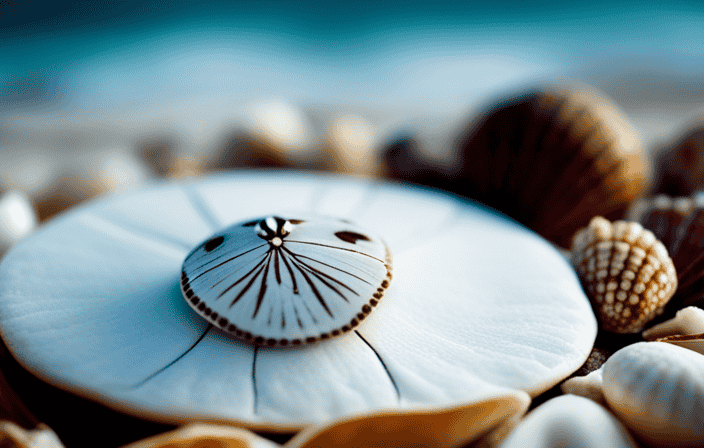
 Meditation2 months ago
Meditation2 months agoThe Symbolic Significance Of Sand Dollar: Spiritual Meanings And Cultural Connections
-

 Inspiration1 month ago
Inspiration1 month agoThe Power Of Spiritual Impartation: Empowering Believers And Cultivating Growth
-

 Inspiration3 months ago
Inspiration3 months agoThe Role And Qualities Of A Spiritual Advisor: A Guide On The Path
-

 Spirituality2 weeks ago
Spirituality2 weeks agoThe Power Of Spiritual Cleansing: History, Benefits, Techniques, And Personal Experiences
-

 Spirituality2 weeks ago
Spirituality2 weeks agoThe Power Of Spiritual Connection: Definition, Importance, And Ways To Achieve












